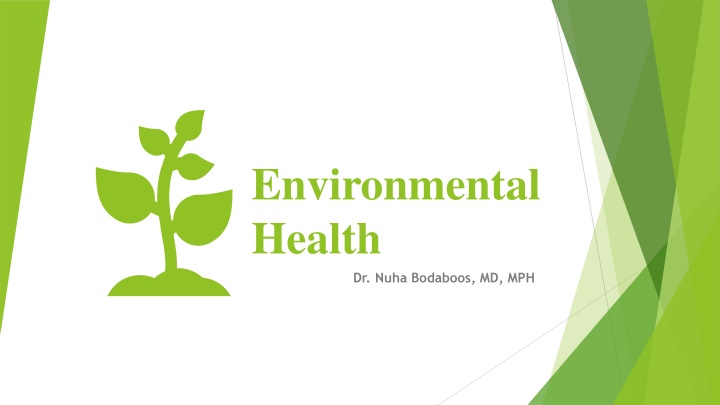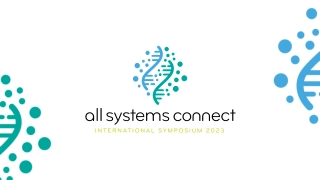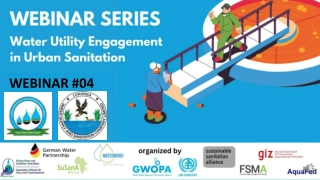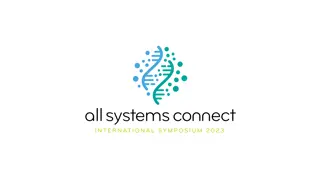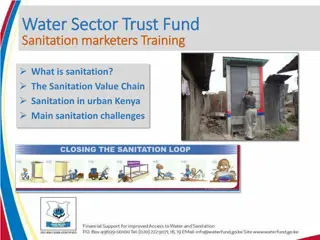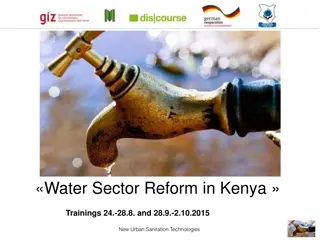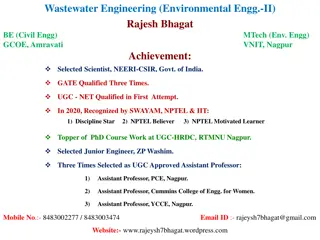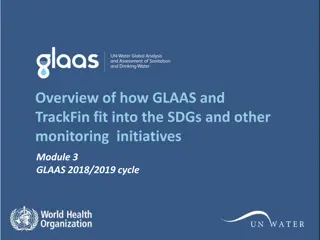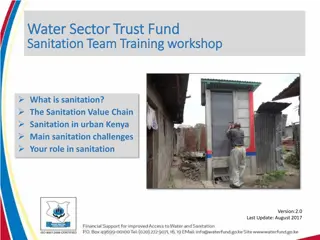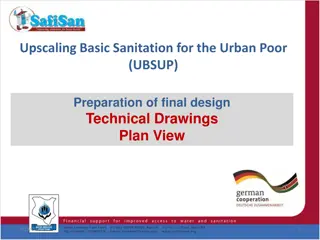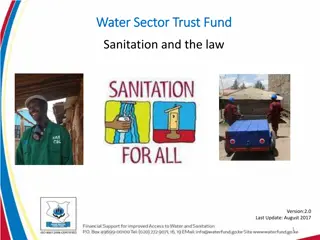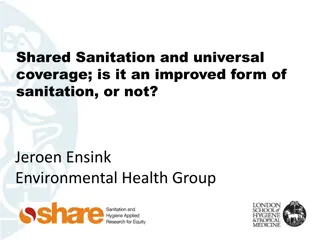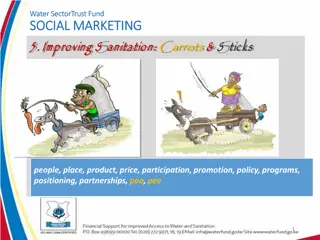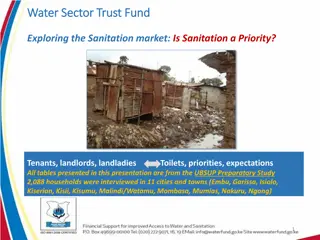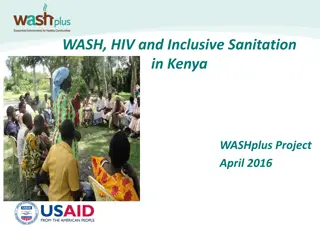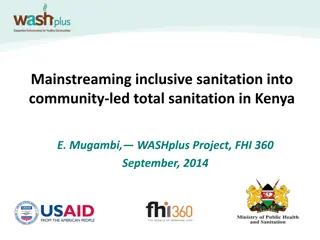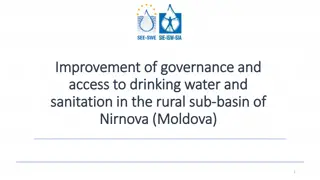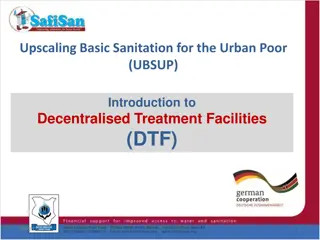Environmental Health and Sanitation Essentials
This content covers the definitions and components of environmental health, focusing on water safety and purification methods. Learn about the purpose of environmental health and the criteria for safe water, as well as water-borne diseases caused by contamination. Explore the steps for water purification through storage, filtration, and disinfection, essential for safeguarding public health.
Download Presentation

Please find below an Image/Link to download the presentation.
The content on the website is provided AS IS for your information and personal use only. It may not be sold, licensed, or shared on other websites without obtaining consent from the author.If you encounter any issues during the download, it is possible that the publisher has removed the file from their server.
You are allowed to download the files provided on this website for personal or commercial use, subject to the condition that they are used lawfully. All files are the property of their respective owners.
The content on the website is provided AS IS for your information and personal use only. It may not be sold, licensed, or shared on other websites without obtaining consent from the author.
E N D
Presentation Transcript
Environmental Health Dr. Nuha Bodaboos, MD, MPH
Definitions: Environment: It means all external factors which surround man Sanitation: The science of safeguarding health. A way of life expressed in the clean home, clean farm, clean neighborhood and the clean community. Environmental Sanitation: The control of all those factors in human s physical environment that may affect his physical development, health and survival. Hygiene: the science of health which contains all factors that contribute to healthful living Contamination: the presence of infectious agent on a body surface or clothes, bedding, toys, surgical instruments, water, milk and food. Pollution: is distinct from contamination and means the presence of offensive but not necessarily infectious matter in the environment.
The purpose of environmental health: Is to create and maintain ecological conditions that will promote health and prevent disease. Environmental components: 1-Physical environment such as water, soil and air 2-Biological environment: All living creatures 3-Social and cultural environment: Income and occupation
Water Safe water criteria: Water pollution: Dissolved gases, minerals, salts, sewage, industrial waste and radioactive substances. Free from pathogens Free from harmful chemical Pleasant taste
Caused by presence of infective agents: Hepatitis A, E, Poliomyelitis typhoid and cholera. Water borne diseases:
Purification of water: Storage Filtration Disinfection
Purification of water Storage: It is considered the first step in water purification by which the total bacterial count may drop by 90% in 5 to 7 days. Filtration: the second important step in water purification is sand filtration, in which water is passed through well constructed sand filters which reduce the total bacterial count by 99%. Disinfection: it is the most critical step in water purification, it can be done by one of the following methods: Chlorination Chlorine dioxide disinfection Ozone disinfection Ultraviolet light
Emergency disinfection of water During an emergency situation like an outbreak of water borne disease 1- Boiling 2- Chemical disinfection by bleaching powder, chlorine tablets, iodine and potassium permanganate.
Waste: Unwanted substance or material produced as a result of a process Solid waste: Liquid waste: Wash water, flushing and human excretion Hazardous waste Organic Recyclable waste
Waste disposal Solid waste disposal Liquid waste(Sewage)
Waste disposal: Solid Waste disposal: Storage by using paper sack and public bins. Collection: The best way of collecting by enclosed vans Controlled tipping (Sanitary landfill): Buried and covered with soil for 4-6 months
Solid Waste disposal: Dumping: A simple method of waste disposal in which refused is dumped in low lying areas outside city limits. Composting: Is a method of combined disposal of refuse and sludge. The compost can be used as a fertilizer. Incineration: It is the best way of disposing the dangerous hospital wastes. Burial: it is suitable for small camps Recycling: Reducing energy loss, consumption of new material an d reduction of landfill.
Liquid Waste Sewage: It is waste water from a community, containing solid and liquid from houses, streets, factories and industries. It is collected from individuals households by a network of underground pipes known as the sewage system, these pipes carry sewage to the place of final disposal where it is purified in sewage treatment plants by biological methods.
Air PRIMARY POLLUTANTS: CO. CO2 AND METHANE SECONDARY POLLUTANTS: OZONE AND SULPHORICACID
Types of air pollution and its effect: Outdoor air pollution: Smog, increase the harmful effects of greenhouse gases and global warming, ozone layer depletion cause increase incidence of respiratory diseases. molds and heating system cause burning eyes, skin irritation, asthma and lung cancer if it is long term exposure Indoor air pollution: More dangerous than out door
Criteria of healthful housing: Provides physical shelter and privacy Prevents spread of disease Protection from environmental hazards
Criteria of overcrowding NUMBER OF PERSONS PER ROOM SEX SEPERATION
Poor housing effect on health: RESPIRATORY INFECTIONS RAT INFESTATION PSYCHOLOGICAL EFFECTS
CO2, Methane and Nitrous oxide When human activities distort those gases means more heat trapped that increase the earth s temperature leading to serious problem worldwide. Greenhouse gases, global warming:
Global Warming: Increase the temperature on earth s surface which may cause dangerous effects: Rising sea level and melting of polar ice caps Heat island phenomenon that makes cities warmer than surrounding rural areas will lead to many attacks of heat waves. Species extinction Change in water supply and contamination of fresh water Increase risk of water borne disease
